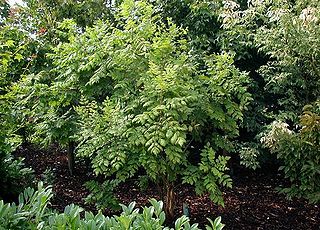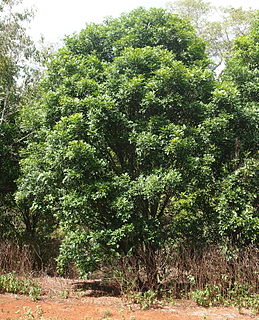
The genus Aesculus, with varieties called buckeye and horse chestnut, comprises 13–19 species of flowering plants in the soapberry and lychee family, Sapindaceae. They are trees and shrubs native to the temperate Northern Hemisphere, with six species native to North America and seven to thirteen species native to Eurasia. Several hybrids occur. Aesculus exhibits a classical Arcto-Tertiary distribution.

Koelreuteria is a genus of three species of flowering plants in the family Sapindaceae, native to southern and eastern Asia.

Dimocarpus is a genus of about 20 species of trees or shrubs known to science, constituting part of the flowering plant family Sapindaceae. They grow naturally in tropical south and Southeast Asia, Malesia, Papuasia and Australasia, including Sri Lanka, India, the Philippines, southern China, Taiwan, Burma, Cambodia, Vietnam, Malaysia, Indonesia, New Guinea, East Timor, far north-eastern Queensland Australia.

Harpullia is a genus of about 27 species of small to medium-sized rainforest trees from the family Sapindaceae. They have a wide distribution ranging from India eastwards through Malesia, Papuasia and Australasia to the Pacific Islands. They grow naturally usually in or on the margins of rainforests or associated vegetation.

Jagera is a genus of 4 species of forest trees known to science, constituting part of the plant family Sapindaceae.

Talisia is a genus of 52 species of flowering plants in the family Sapindaceae, native to tropical regions of the Americas. The genus is closely related to Melicoccus, with some species sometimes included in that genus.

Arytera is a genus of about twenty–eight species known to science, of trees and shrubs and constituting part of the plant family Sapindaceae. They grow naturally in New Guinea, Indonesia, New Caledonia, Australia, the Solomon Islands, Vanuatu, Fiji, Samoa, Tonga; and the most widespread species and type species A. littoralis grows throughout Malesia and across Southeast Asia, from NE. India, southern China, Borneo, Malaysia, Singapore, Indonesia and the Philippines to as far east as New Guinea and the Solomon Islands.

Atalaya is a genus of eighteen species of trees and shrubs of the plant family Sapindaceae. As of 2013 fourteen species grow naturally in Australia and in neighbouring New Guinea only one endemic species is known to science. Three species are known growing naturally in southern Africa, including two species endemic to South Africa and one species in South Africa, Swaziland and Mozambique.

Elattostachys is a genus of about 21 species of trees known to science, constituting part of the plant family Sapindaceae.

Mischocarpus is a genus of about nineteen species of trees known to science, constituting part of the plant family Sapindaceae. They grow naturally from Australia and New Guinea, though Malesia as far north as the Philippines, through SE. Asia, Indo-China and S. China, to India at their farthest west. The eleven Australian species known to science grow naturally in the rainforests of the eastern coastal zone of New South Wales and Queensland, from Newcastle northwards through to north-eastern Queensland and Cape York Peninsula.

Xanthoceras sorbifolium, the yellowhorn, shiny leaf yellowhorn, goldenhorn, or Chinese flowering chestnut, is a species of flowering plant in the soapberry family Sapindaceae, and the only species in the genus Xanthoceras. It is native to northern China in the provinces of Gansu, Hebei, Henan, Liaoning, Nei Monggol, Ningxia, Shaanxi, and Shandong. It is also cultivated in Russia, having been imported there since the 19th Century.

Callicarpa bodinieri, or Bodinier's beautyberry, is a species of flowering plant in the genus Callicarpa of the family Lamiaceae, native to West and Central China. Growing to 3 m (10 ft) tall by 2.5 m (8 ft) wide, it is an upright deciduous shrub with dark green leaves turning red in autumn (fall). In midsummer, small lilac flowers are produced in the leaf axils. But it is grown in gardens primarily for its small, decorative purple berries in tight clusters in autumn. While the berries are not poisonous, they are very bitter. Wildlife will not eat them until there are no other available food sources. This species is more tolerant of cold than C. americana.

Lepisanthes is a genus of 24 or 25 species of trees or shrubs native to tropical Africa, south and southeast Asia, Australia, and Madagascar.

Libo County is a county of southern Guizhou province, China, bordering Guangxi to the south. It is under the administration of the Qiannan Buyei and Miao Autonomous Prefecture.
Synima is a genus of tropical rainforest trees, constituting part of the plant family Sapindaceae.
Lepidopetalum is a genus of six species of trees known to science, constituting part of the plant family Sapindaceae.
Mahonia bodinieri is a shrub in the Berberidaceae described as a species in 1908. It is endemic to China, found in the provinces of Guangdong, Guangxi, Guizhou, Hunan, Jiangxi, Sichuan, and Zhejiang.

Acer amplum is an Asian species of maple found in Vietnam and China.

Sapindoideae is a subfamily of flowering plants in the soapberry family, Sapindaceae.














